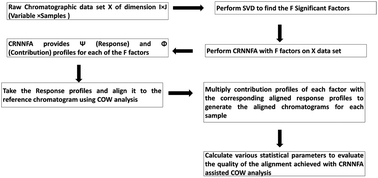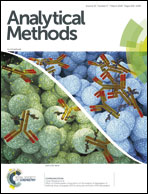Chemometric assisted correlation optimized warping of chromatograms: optimizing the computational time for correcting the drifts in chromatographic peak positions†
Abstract
Correlation optimized warping has been the most used technique to correct the drifts in peak positions. COW aligns the unaligned chromatogram to the reference chromatogram provided slack (t) and segment lengths (m) are optimized. However, several combinations of m and t need to be tested before finding the optimum combination of m and t. The optimization of these two parameters is laborious and computationally time consuming. The computational time significantly increases with the number of samples. As a result, often the correction of the retention time drifts becomes the bottleneck in the data analysis workflow. The present work shows that the application of constraint randomized non-negative factor analysis (CRNNFA), a chemometric technique, prior to COW can optimize the computational time by reducing the volume of datasets and subsequently allows a swift correction of drifts in peak positions. The utility of the proposed approach is successfully demonstrated by analyzing simulated as well as real life chromatograms. It is expected that this proposed approach will be useful and would be successfully integrated in the data analysis workflow related to research dealing with the finding of chemical, biochemical or clinical markers.



 Please wait while we load your content...
Please wait while we load your content...